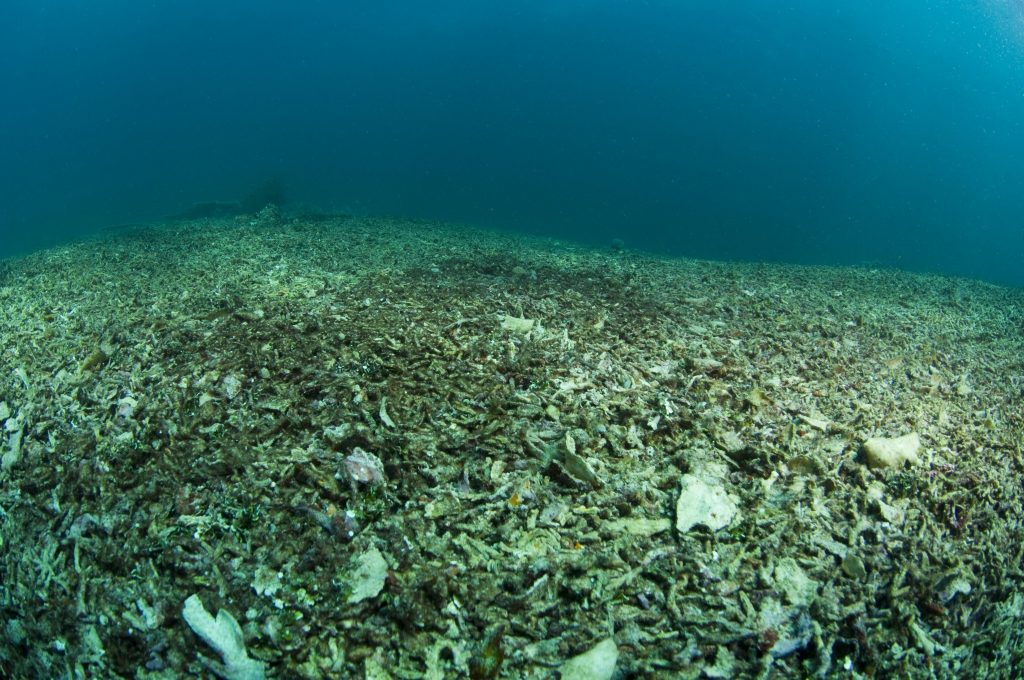Overfishing and Destructive Fishing
Unsustainable fishing has been identified as the most pervasive of all local threats to coral reefs. ref Over 55% of the world’s reefs are threatened by overfishing and/or destructive fishing. Overfishing (i.e., catching more fish than the system can support) leads to declines in fish populations, ecosystem-wide impacts, and impacts on dependent human communities. Destructive fishing is associated with some types of fishing methods including dynamite, gill nets, and beach seines. These harm coral reefs not just through physical impacts but also through by-catch and mortality of non-target species including juveniles.

Reef bombed for fishing in Indonesia. Photo © Jeff Yonover
Overfishing, Destructive Fishing, and Reef Resilience
Overfishing and destructive fishing negatively impact the ecological and social resilience of the reef and associated communities. Overfishing can have dramatic impacts on reef biodiversity and disrupts fragile interactions among reef organisms. The removal of herbivores, in particular, can be especially harmful, as it diminishes the reef’s ability to absorb and recover from disturbances.
Destructive fishing methods, specifically dynamite fishing, can destroy coral reefs, reducing them to rubble with little structural complexity, severely hindering their natural ability to stabilize and regenerate. These impacts will have cascading negative effects on the livelihoods of associated communities, particularly those relying on fisheries and on coastal protection from complex reef habitats.
Management Strategies
Marine protection through the establishment of specific Marine Protected Areas (MPAs), Locally Managed Marine Areas (LMMAs), Marine Conservation Agreements (MCAs), or Other Effective Area-Based Conservation Measures (OECMs) is the most common strategy to manage overfishing and destructive fishing practices.
Managing herbivores is particularly important, as herbivores, are essential for supporting reef resilience and preventing macroalgae from over-growing corals.
A range of conventional fisheries management tools and strategies are available for protecting herbivores. These include:
Protected Areas
Prohibiting removal of herbivores (or general bans on fishing) in portions of habitat or at sites important for herbivores (such as aggregation sites) can help maintain herbivore populations.
Gear restrictions
Herbivores generally are not caught in hook and line fisheries, and instead are targeted using traps, nets, or spears. Some herbivorous fishes, such as parrotfishes, are especially vulnerable to nocturnal spearfishing and spearfishing on SCUBA. Limiting use of certain types of fishing gear or fishing times can reduce pressure on herbivores.
Species bans
The most effective way to protect herbivores is to place a total ban on collection of key herbivore species. Market-based approaches, such as prohibiting the sale of herbivores, can prevent commercial fishing for herbivorous species although subsistence fisheries can still be a significant source of pressure in many locations.
Temporary closures
The role of herbivores can be especially important during periods of environmental stress and in the recovery phase. Managers can consider a temporary restriction on harvesting important herbivore species to maximize the chance that coral populations will be able to recover without the added pressure of excessive competition with algae. Temporary fishing bans may also be put in place in known spawning periods for some herbivores or commercially important species.
Herbivore restoration
In cases where herbivore populations have been reduced through overfishing or disease, active restoration may be the most feasible way to rebuild populations to the level required to prevent or reverse a phase shift. Depleted urchin populations have been the focus of assisted recovery trials in some places where they are one of the main sources of herbivory (which may be symptomatic of depleted fish herbivore populations), but there have not yet been any examples of successful broad-scale restoration.

Parrotfish control algal growth and maintain the reef substrate for coral recruitment. Photo © Jeff Yonover
Read more about threats and management strategies for overfishing in the Reef Fisheries Toolkit and more about Marine Protected Areas and their role in managing overfishing and destructive fishing in the MPA Toolkit.
